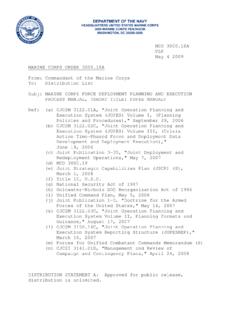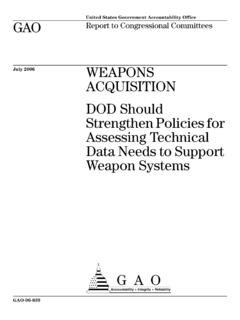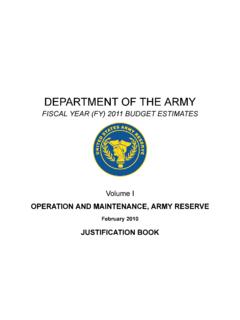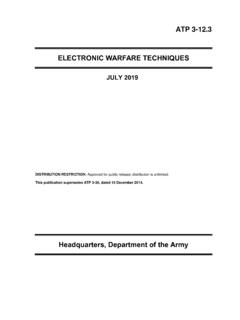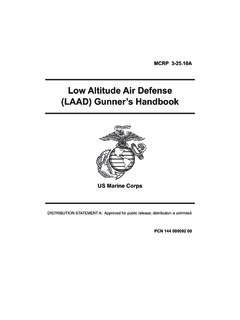Transcription of Basic Formations, Movement Techniques, and Hand-and-Arm ...
1 FM 5-10 Basic Formations, Movement Techniques, and Hand-and-Arm Signals A-1 APPENDIX ABasic Formations, Movement Techniques, and Hand-and-Arm SignalsThe platoon uses a variety of mounted and dismounted formations and movementtechniques to maneuver on the battlefield. This appendix gives examples of manyof the Basic formations, Movement techniques, and Hand-and-Arm signals the pla-toon leader could use. It is not designed to be all encompassing. For more informa-tion on these topics, see FMs 7-8, 5-34, and Movement TECHNIQUESThe mounted engineer platoon must be proficient in moving with its maneuver counterpart. In the following paragraphs, formations, Movement techniques, and actions taken during Movement for the mounted engineer platoon are engineer platoon almost always maneuvers as part of another larger forma-tion.
2 Normally, this will either be the parent engineer company or a maneuvercompany/team. Figure A-1, page A-2, shows the formation that the platoon is mostlikely to use. The platoon wedge provides the most defensible formation with theeasiest C2. Ordinarily, the platoon follows a maneuver platoon if task-organized toa maneuver company/team. The platoon might lead if it is part of the engineercompany formation. In either case, the wedge is the best formation to use if enemycontact is platoon frequently receives assets from the assault and obstacle (A&O) pla-toon. These could include the AVLB, CEV, or armored vehicle-launched mine-clearing line charge (AVLM).
3 These additional vehicles can strain the C2 capabil-ity of the platoon. Figure A-2, page A-2, shows the technique of "tethering". TheAVLB, CEV, and AVLM are tethered to individual engineer squads. Each squadleader has the responsibility of commanding and controlling an A&O platoon improves the C2 of the platoon and provides each A&O asset with a securityelement as it moves across the A-3, page A-3, shows a simple wedge formation. Note where the key leadersin the platoon are. The wedge formation uses the wingman concept. The platoonsergeant and leader are both in APCs and each has a wingman. This techniqueFM 5-10A-2 Basic Formations, Movement Techniques, and Hand-and-Arm SignalsReinforced engineer platoon moving withthe breach forceCEVAPCAVL MAV LBAPCAPCAPCM1 tankwith plowM1 tankwith plowM1 tankwith plowM1tankFigure A-1.
4 Engineer platoon with the breach forceAPCAPCAPCAPCAV LMAV LBCEVF igure A-2. Modified mounted wedge formationFM 5-10 Basic Formations, Movement Techniques, and Hand-and-Arm Signals A-3also simplifies C2 and Movement . It has the added benefit of placing the mostexperienced leader in the platoon, the platoon sergeant, forward with the also places the platoon sergeant where he can easily take over in the absence ofthe platoon A-4, page A-4, depicts a column formation. This formation is used whenenemy contact in not expected. This formation maximizes C2 and the speed of theformation. Normally, the platoon transitions from the column to the wedge asenemy contact becomes more A-5, page A-4, shows the platoon in a line formation.
5 This formation isdesigned to maximize the forward firepower of the platoon. The platoon transitionsfrom the wedge to the line as enemy contact becomes eminent. Engineer platoonsdo not generally use this formation. However, if the platoon is tasked to suppress adismounted threat while another platoon maneuvers, this formation works A-3. Mounted wedge formationFM 5-10A-4 Basic Formations, Movement Techniques, and Hand-and-Arm SignalsSquadleaderSquadleaderPlatoonlead erPlatoonsergeant50-100 m50-100 m50-100 m between APCsFigure A-4. Mounted column formationPlatoon leaderPlatoon sergeant2d squad3d squad1st squad50-100 mFigure A-5. Mounted line formationFM 5-10 Basic Formations, Movement Techniques, and Hand-and-Arm Signals A-5 ECHELONThe echelon formation is used when the platoon is on the flank of the company andthe enemy threat is also from the flank.
6 Figure A-6 shows an echelon right forma-tion. The echelon formation can also be used on the left flank of the company and,in that case, it would be the mirror image of Figure A-6. This formation maximizesthe platoon's firepower to the V-formation is a variation of the wedge. It is used when there is a significantthreat of command-detonated mines or explosives. The formation shown in Figure A-7,page A-6, would be used during a route-clearance operation. It allows the platoonto secure the flanks of the road while two squads clear the route. This formationalso identifies command-detonated-mine firing wires or ambushes before theenemy can attack the element on the route.
7 It is not generally used when there is asignificant enemy squadPlatoon leaderPlatoon sergeant2d squad3d squad50-100 mFigure A-6. Mounted echelon formationFM 5-10A-6 Basic Formations, Movement Techniques, and Hand-and-Arm SignalsDISMOUNTED Movement TECHNIQUESThe dismounted engineer platoon must be proficient in moving with its maneuvercounterpart. In the following paragraphs, formations, Movement techniques, andactions taken during Movement for the dismounted engineer squad and platoon FORMATIONSThe squad formation is built from the fire-team wedge (see Figure A-8). The inter-val between soldiers in the wedge formation is normally 10 meters. The wedgeexpands and contracts depending on the terrain.
8 When rough terrain, poor visibil-ity, or other factors make control of the formation difficult, the squad uses the mod-ified wedge. In this formation, the normal interval between soldiers is reduced sothat all team members can still see their team leader and each team leader can seetheir squad leader. The sides of the wedge can contract to the point where thewedge resembles a single file. When moving in less rugged terrain, where control iseasier, soldiers expand the formation or resume their original mPlatoon leaderPlatoon sergeant2d squad3d squad1st squadFigure A-7. Mounted V-formationFM 5-10 Basic Formations, Movement Techniques, and Hand-and-Arm Signals A-7 PLATOON FORMATIONSP latoon formations are built from multiple squad formations.
9 These formationsinclude the platoon column, line, V, and wedge. The platoon leader selects the bestformation based on his METT-T analysis. Table A-1, page A-8, shows a comparisonof each formation and its operatorPlatoon leaderPlatoon sergeantSquad leaderSquad leaderRadio-telephone operatorRadio-telephone operatorNOTE: Unlabeled positions are dismounted m10 mFire-teamwedgeSquadformationSquad leaderRadio-telephone operatorFigure A-8. Dismounted-platoon wedge formationFM 5-10A-8 Basic Formations, Movement Techniques, and Hand-and-Arm SignalsTable A-1. Comparison of platoon formationsDismounted MovementFormationsMovementUseMovement CharacteristicsControlFlexibilityFire Capability/RestrictionMarch RateColumnWhen the pla-toon performs primary move-ment forma-tionsGood for maneuver (fire and Movement )
10 Provides good disper-sion laterally and in depthAllows limited firepower to the front and rear, high vol-ume to the flankGoodLineWhen the enemy situa-tion is unknown and the leader wants all sol-diers forward for maximum firepower to the frontDifficultIs minimalAllows maxi-mum fire-power to the front, little to the flanks and rearSlowVWhen the enemy situa-tion is vague, but contact is expected from the frontDifficultProvides two squads up front for immediate firepower and one squad to the rear for Movement upon contact from the flankAllows an immediate heavy vol-ume of fire-power to the front or flanksSlowWedgeWhen the enemy situa-tion is vague, but contact is not expectedDifficult but better than the platoon V and platoon lineEnables the leader to make contact with the smallest ele-ment and still have two squads to maneuverProvides a heavy vol-ume of fire-power to the front or flanksSlow but faster than the platoon VFileWhen visibil-ity is poor due to terrain or lightEasiestIs the most difficult forma-tion from which to maneuverAllows imme-diate fires to the flanks.


